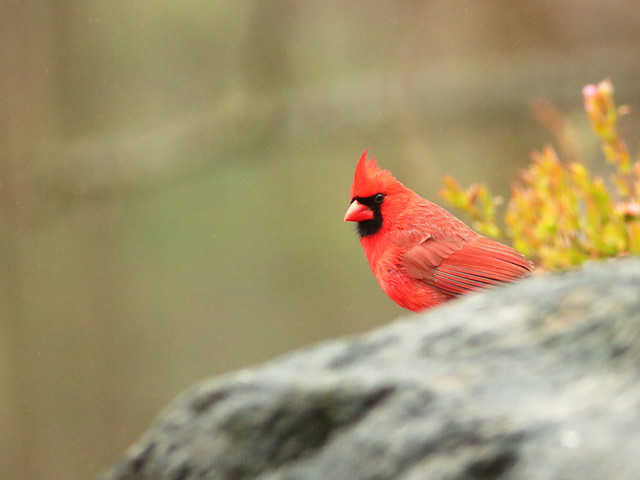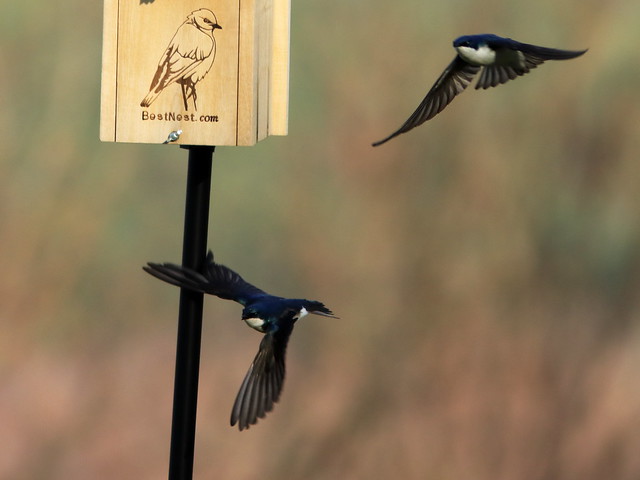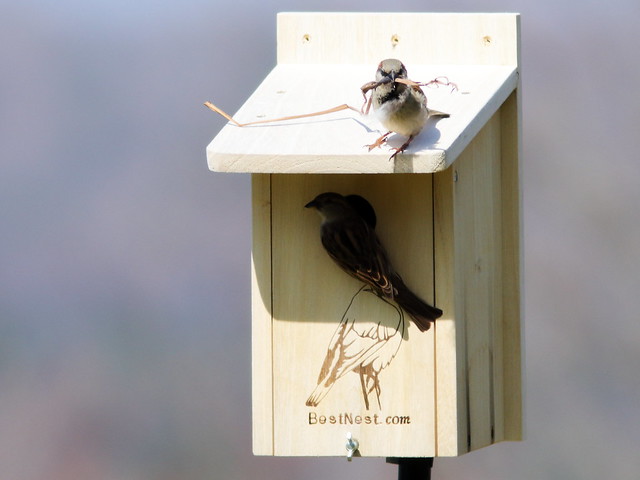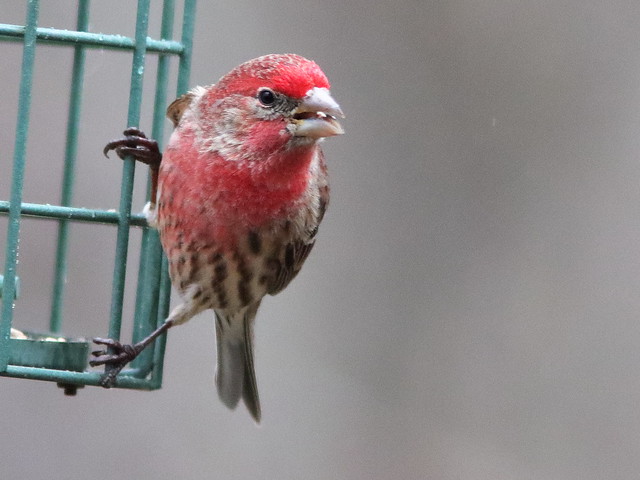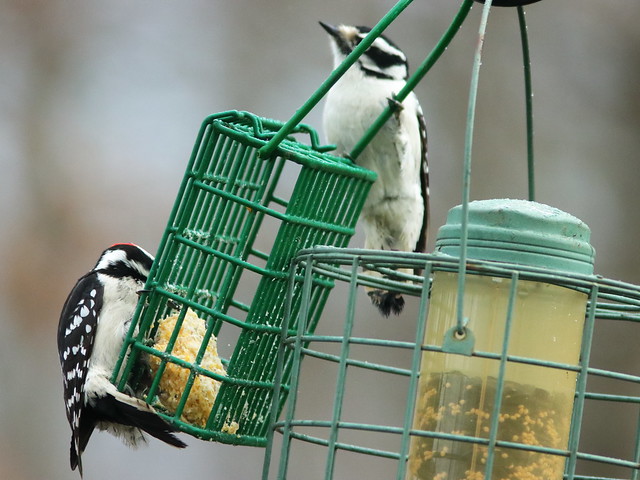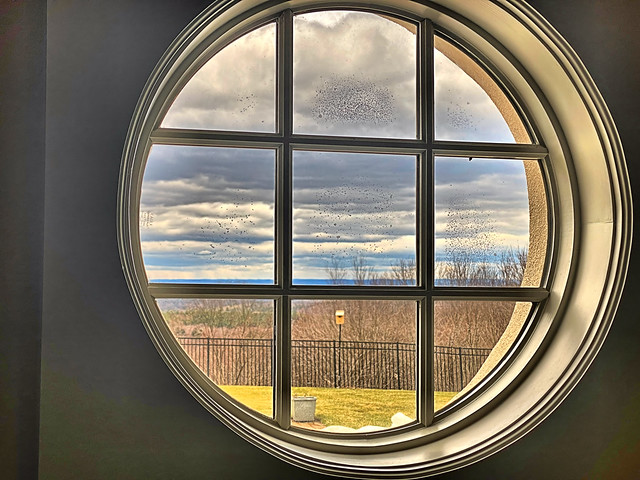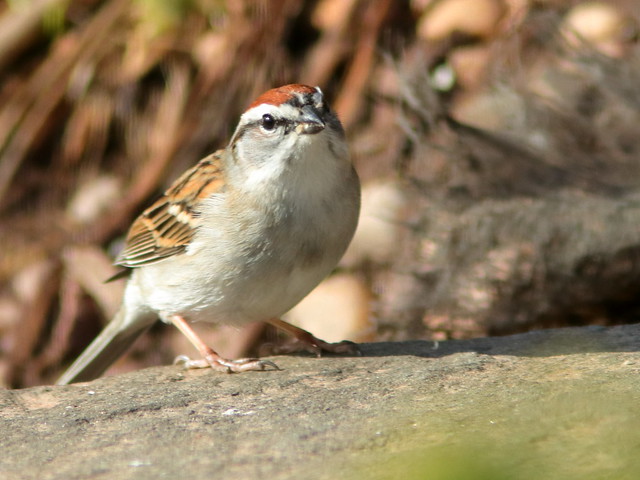The weather here moderated during the past week, providing us with more opportunities to walk outside between the rain showers, but near-freezing temperatures are expected to persist for the next several days. A few returning migrants have been reported locally. I heard an Indigo Bunting singing but never caught sight of it. Winter visitors such as the juncos and White-throated Sparrows have disappeared and the plumage of the male goldfinches is in full breeding splendor.
A Northern Cardinal posed nicely amid buds on a rain-soaked branch:
A wet but perky White-breasted Nuthatch appeared:
On a sunlit morning. a cardinal emerged from behind one of the many granite boulders which surround the house:
Our Eastern Bluebirds have had mixed success at our two nest boxes. We are quite sure that one pair has eggs in the box near the edge of the woodland. They successfully warded off competitors such as Black-capped Chickadees and Tufted Titmice.
Another pair of bluebirds claimed the one which is located in the back lawn way from the trees. They faced competition from Tree Swallows, known to prefer boxes in open areas.
On April 19, a flock of Tree Swallows swept in and displaced the bluebirds, which did not put up much of a fight:
The swallows occupied the nest box for about three days, even squabbling with each other over which might claim squatters' rights:
One pair of swallows seemed to have won the prize:
Tree Swallows are handsome birds and graceful fliers (and they consume large numbers of mosquitoes):
The vanquished male bluebird sat passively by after losing a few aerial battles:
Unexpectedly, a new competitor arrived on the scene. I had seen absolutely no House Sparrows until a male of this exotic and invasive species showed up at the feeder on April 23:
That same day I saw the male and a female trying to gain entrance to the nest box. At first the swallows chased them away, but the sparrows were very aggressive and persistent:
Very quickly, the House Sparrows stuffed the nest with dead grass and leaves:
The swallows appeared to have surrendered. Only one remained, sometimes skirmishing ineffectively with the sparrows and often perching near them. (Speaking anthropomorphically, the sparrows were not ready to negotiate a truce):
On each of the ensuing days, I have gone out morning and afternoon to remove the sparrows' nesting material, but they are able to replenish it within an hour or so. I love birds, but wish to extend hospitality only to native hole-nesting species such as bluebirds, swallows, chickadees, titmice and wrens. The Tree Swallows still linger periodically, although none have been seen in any more open combat between the species.
I will continue to dissuade the House Sparrows which, along with introduced European Starlings, competed for nesting holes in forests depleted of old growth trees. This contributed to near-extinction of Eastern Bluebirds in the early 1900s .
On a more peaceful note, I finally photographed the Pileated Woodpecker which I had seen flying over the property twice before. It became the 36th species photographed of the 45 I have seen on or over the property. Not a good image, but its red "mustache" renders it recognizable as a male:
Also on April 26, until turned back by misty precipitation, we walked along the shore of adjacent Diamond Lake. Here is a view of what we could see of the lake, through the trees in the front yard, on April 23rd:
We followed a circuitous route which led along a bluff above the lake:
Dooryard gardens were beginning to show some spring beauty:
Breezes stirred the surface of the lake, signaling rain:
A parting shot of a fine Daffodil next to our mailbox:
Linking to:
Skywatch Friday
Weekend Reflections
Saturday's Critters
BirdD'Pot
All Seasons
Wordless Wednesday (on Tuesday)
Natasha Musing
_______________________________________________
Please visit the links to all these posts to see some excellent photos on display
________________________________________________



